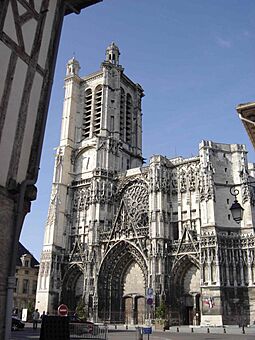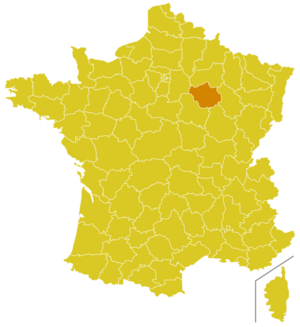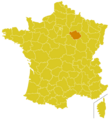Roman Catholic Diocese of Troyes facts for kids
Quick facts for kids Diocese of TroyesDioecesis Trecensis Diocèse de Troyes |
|
|---|---|

Troyes Cathedral
|
|
| Location | |
| Country | France |
| Ecclesiastical province | Reims |
| Metropolitan | Archdiocese of Reims |
| Statistics | |
| Area | 6,028 km2 (2,327 sq mi) |
| Population - Total - Catholics |
(as of 2014) 303,997 216,800 (71.3%) |
| Parishes | 44 ('new parishes') |
| Information | |
| Denomination | Catholic Church |
| Sui iuris church | Latin Church |
| Rite | Roman Rite |
| Established | 4th century |
| Cathedral | Cathedral of St. Peter and St. Paul in Troyes |
| Patron saint | |
| Secular priests |
|
| Current leadership | |
| Pope | Francis |
| Bishop elect | Alexandre Joly |
| Metropolitan Archbishop | Éric de Moulins-Beaufort |
| Emeritus Bishops | Marc Stenger |
| Map | |
 |
|
The Diocese of Troyes is a special area of the Catholic Church in Troyes, France. It is like a church district led by a bishop. This diocese was created in the 4th century and now covers the area of Aube. It is part of the larger Archdiocese of Reims.
Over time, the size and connections of the Diocese of Troyes have changed. In 1802, it became part of the Archbishopric of Paris. Later, in 1822, it lost some areas when new dioceses were formed. In 2002, it returned to being part of the Archdiocese of Reims, which was its original connection. In 2014, there was about one priest for every 2,710 Catholics in the diocese.
For a long time, there was a bit of a power struggle between the Bishop of Troyes and the local ruler, the Count of Champagne. When the King of France became more powerful after 1314, the King's influence grew, and the Bishop had less say in certain matters, especially concerning royal churches.
Contents
History of the Diocese
The list of bishops for Troyes goes back to the 9th century and is thought to be quite reliable from the 5th century onwards. The first known bishop, St. Amator, was followed by Bishop Optatianus around 344 AD.
During Bishop Ottulph's time (870-883), work began to rebuild the cathedral, which was in bad shape. He also found the body of Saint Frobert, which became a special object of respect. In 878, Pope John VIII even visited Troyes, seeking safety from conflict in Italy. Sadly, in 889, the whole town of Troyes was burned down by invaders from the North, known as Northmen.
Several important church meetings, called councils, have been held in Troyes. These include meetings in 867, 878 (led by Pope John VIII), 1078, 1104, and 1107 (led by Pope Paschal II).
Cathedral and Churches
The Cathedral of Troyes is a beautiful Gothic building. Its construction started in the 12th century and finished in the 15th century. The cathedral has a group of leaders called the Chapter, which includes a Dean, Treasurer, and several Archdeacons. One famous Dean was Petrus Comestor (around 1110–1179), who was born in Troyes and later became a professor in Paris.
The diocese also had ten "collegiate churches." These were churches with a group of clergy, but they were not cathedrals. One important example was Saint-Étienne in Troyes, which was a royal church.
The ancient collegiate Church of St. Urbain is another stunning Gothic building. Its construction began in 1262 by Pope Urban IV, who was from Troyes. He even had his father, a tailor, shown in one of the church's stained-glass windows.
In 1353, a collegiate church was founded at Lirey, where a special cloth, believed by some to be the Holy Shroud, was displayed. However, the Bishop of Troyes at the time said it was just a painting, and the person who made it even admitted it. Despite this, Pope Clement VI allowed it to be shown. This cloth later ended up in Turin.
The French Revolution
During the French Revolution (1789-1799), many things changed in France, including the church. The Diocese of Troyes was officially closed down in 1790. Its area became part of a new diocese called 'Aube'. Many priests in Troyes took an oath to the new government, but the bishop, Louis-Mathias-Joseph de Barral, refused and left France.
Those priests who did not take the oath faced difficulties. Many left the country, and those who were too old or sick were put in prison. Church buildings were used for other purposes, and the seminary (a school for priests) closed down.
Bishop de Barral later changed his mind about the oath, but in 1801, he resigned as bishop when Pope Pius VII asked all French bishops to do so. He then became the Bishop of Meaux.
In Troyes, a new bishop, Augustin Sibille, was elected by the people in 1791. However, his appointment was not approved by the Pope. Later, in 1793, all churches were closed, and religion was abolished by the government. Bishop Sibille resigned from the priesthood to avoid danger.
During this time, many religious communities were forced to leave their convents and monasteries. Their properties and goods were sold off. Even the remains of important historical figures, like the Counts of Champagne, were moved. The remains of Saint Bernard and Malachy of Armagh were also removed from their tombs. Later, in 1875, these remains were brought to the Cathedral in Troyes, where they are still kept today.
Religious Houses
The Abbey of Nesle la Riposte was founded a very long time ago, before 545 AD. It was said to have been founded by Queen Clotilde. An interesting detail is that a statue of a "web-footed queen" was seen in its doorway, which some believed was St. Clotilde.
The Abbey of Notre Dame aux Nonnains was an important abbey for women. It had a unique tradition: when a new bishop was installed, he would stay at the abbey the night before. The bed he slept on became his, but the mule he rode became the abbess's property! The abbess would also lead the bishop by the hand and give him his special hat (mitre) and staff (crozier).
The famous Abbey of Clairvaux, known for St. Bernard of Clairvaux, was located in an area that used to be part of the Diocese of Langres. This abbey was special because it answered directly to the Pope, not the local bishop.
The Abbey of the Paraclete was founded by the famous poet and thinker Peter Abelard. His partner, Heloise, died there in 1163 and was buried there. Abelard's remains were also buried there, but they were removed during the Revolution. Nothing remains of the abbey today.
Religious Orders in Troyes
Many religious orders have had a presence in Troyes. In the 17th and 18th centuries, groups like the Oratorians were active. In the 19th century, before the separation of church and state in France, there were Benedictines, Jesuits, and others. Many female religious groups also started in the diocese, including the Sisters of Christian Instruction and the Oblate Sisters of St. Francis de Sales, who focused on teaching. The Sisters of Notre Dame de Bon Secours were a nursing community.
Bishops of Troyes
Early Bishops (to 1000 AD)
- Amator, around 340
- Optatius, 346–347
- Saint Lupus I (426–478) – a very important early bishop
- Saint Camelianus (479–536)
- Saint Vincent, 536–546
- Gallomagnus, 573–582
- Saint Leuconius (651–656)
- Saint Bobinus (750–766)
- Saint Prudentius, 845–861 – known for his writings
- Ottulf, around 880
- Bodon, around 890 – during his time, Troyes was burned by Northmen.
- Ansegisel, 914–970
Recent Bishops (from 1800)
- Marc-Antoine de Noé (1802)
- Louis-Apolinaire de La Tour du Pin-Montauban (1802–1807)
- Etienne-Marie de Boulogne (1808–1825)
- Marc Camille Michel Stenger (1999–2020)
- Alexandre Joly (appointed 2021 – present)
Saints Connected with the Diocese
Many saints are specially honored or have connections to the Diocese of Troyes:
- Sabinian of Troyes, believed to be an early apostle of Troyes.
- St. Frobert, who founded the Abbey of Montier le Celle.
- St Aderaldus, a canon of Troyes who founded a monastery.
- St. Robert, who founded the famous monasteries of Molesme and Cîteaux.
- St. Bernard of Clairvaux, the first Abbot of Clairvaux, a very influential figure in the church.
- Marguerite Bourgeoys (1620–1700), who founded the Congregation of Notre Dame in Montreal, was from this diocese.
- Marie de Sales Chappuis, a superioress of a convent in Troyes.
Images for kids
See also
- List of bishops of Troyes
- G-Catholic, Diocese of Troyes France, retrieved: 2016-09-22.
- Diocèse de Troyes
- Relics of St. Bernard, Treasury, Cathedral of SS. Peter and Paul, Troyes. Retrieved: 2016-09-26.
Acknowledgment
- Goyau, Georges. "Troyes." The Catholic Encyclopedia. Vol. 15. New York: Robert Appleton Company, 1912. Retrieved: 2016-09-22.
 This article incorporates text from a publication now in the public domain: "Troyes". Catholic Encyclopedia. (1913). New York: Robert Appleton.
This article incorporates text from a publication now in the public domain: "Troyes". Catholic Encyclopedia. (1913). New York: Robert Appleton.




